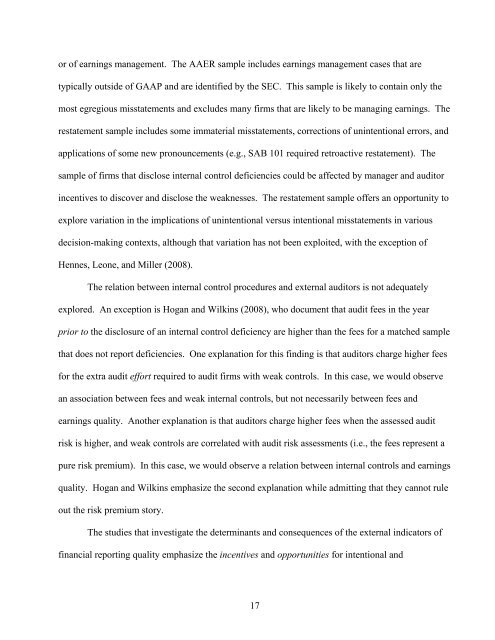Understanding earnings quality - MIT Sloan School of Management
Understanding earnings quality - MIT Sloan School of Management
Understanding earnings quality - MIT Sloan School of Management
Create successful ePaper yourself
Turn your PDF publications into a flip-book with our unique Google optimized e-Paper software.
or <strong>of</strong> <strong>earnings</strong> management. The AAER sample includes <strong>earnings</strong> management cases that are<br />
typically outside <strong>of</strong> GAAP and are identified by the SEC. This sample is likely to contain only the<br />
most egregious misstatements and excludes many firms that are likely to be managing <strong>earnings</strong>. The<br />
restatement sample includes some immaterial misstatements, corrections <strong>of</strong> unintentional errors, and<br />
applications <strong>of</strong> some new pronouncements (e.g., SAB 101 required retroactive restatement). The<br />
sample <strong>of</strong> firms that disclose internal control deficiencies could be affected by manager and auditor<br />
incentives to discover and disclose the weaknesses. The restatement sample <strong>of</strong>fers an opportunity to<br />
explore variation in the implications <strong>of</strong> unintentional versus intentional misstatements in various<br />
decision-making contexts, although that variation has not been exploited, with the exception <strong>of</strong><br />
Hennes, Leone, and Miller (2008).<br />
The relation between internal control procedures and external auditors is not adequately<br />
explored. An exception is Hogan and Wilkins (2008), who document that audit fees in the year<br />
prior to the disclosure <strong>of</strong> an internal control deficiency are higher than the fees for a matched sample<br />
that does not report deficiencies. One explanation for this finding is that auditors charge higher fees<br />
for the extra audit effort required to audit firms with weak controls. In this case, we would observe<br />
an association between fees and weak internal controls, but not necessarily between fees and<br />
<strong>earnings</strong> <strong>quality</strong>. Another explanation is that auditors charge higher fees when the assessed audit<br />
risk is higher, and weak controls are correlated with audit risk assessments (i.e., the fees represent a<br />
pure risk premium). In this case, we would observe a relation between internal controls and <strong>earnings</strong><br />
<strong>quality</strong>. Hogan and Wilkins emphasize the second explanation while admitting that they cannot rule<br />
out the risk premium story.<br />
The studies that investigate the determinants and consequences <strong>of</strong> the external indicators <strong>of</strong><br />
financial reporting <strong>quality</strong> emphasize the incentives and opportunities for intentional and<br />
17
















